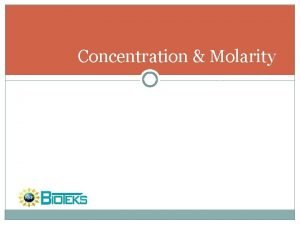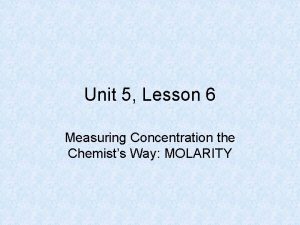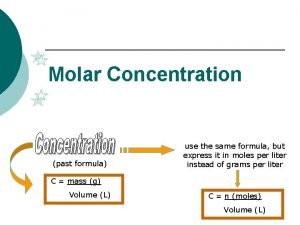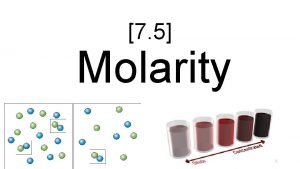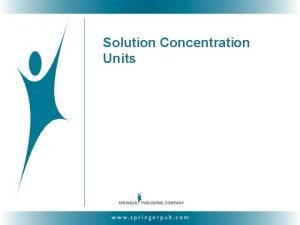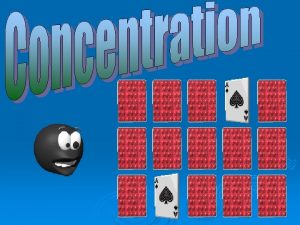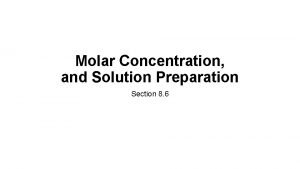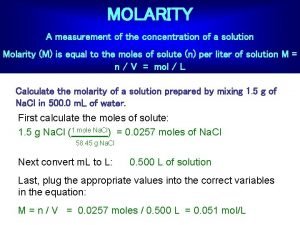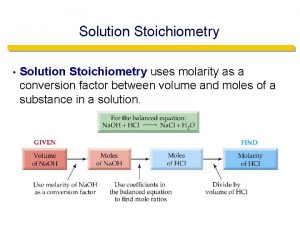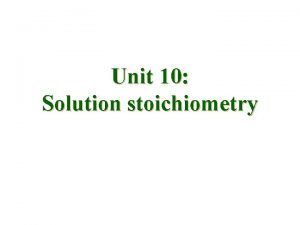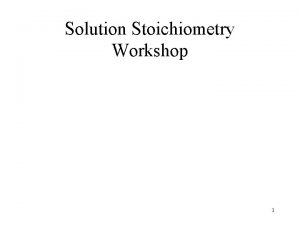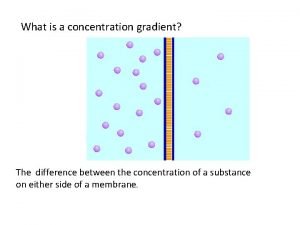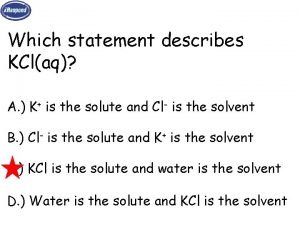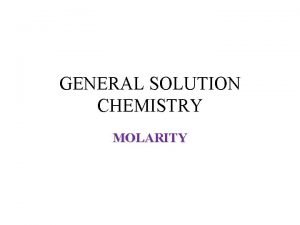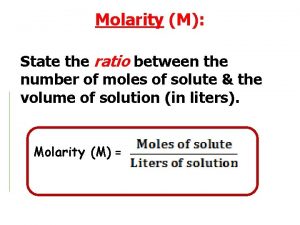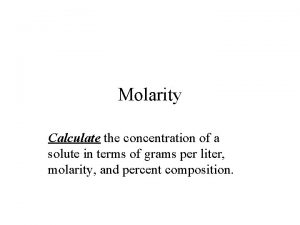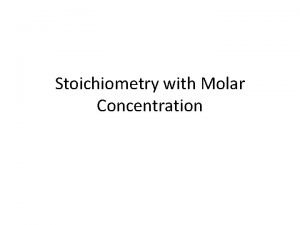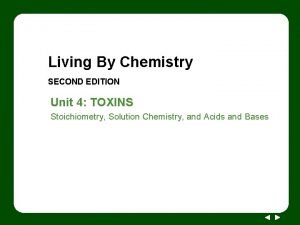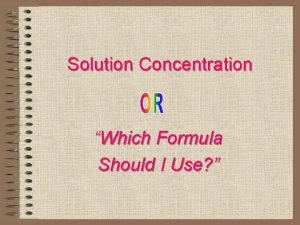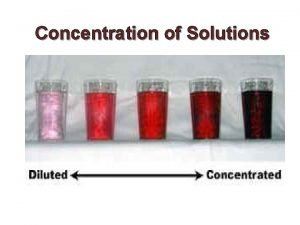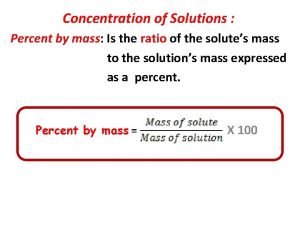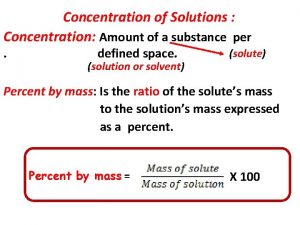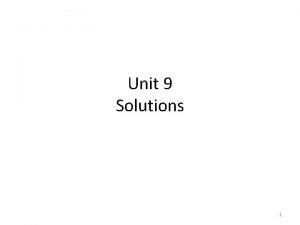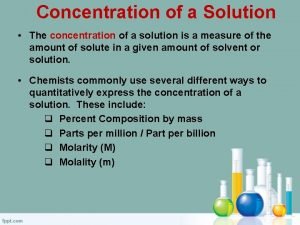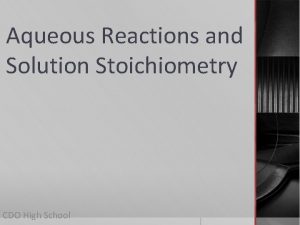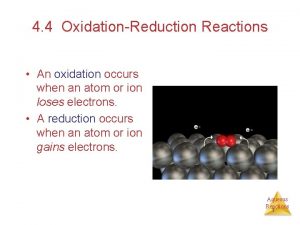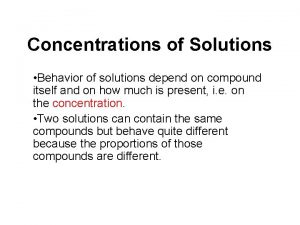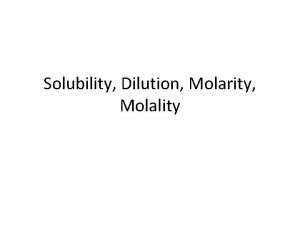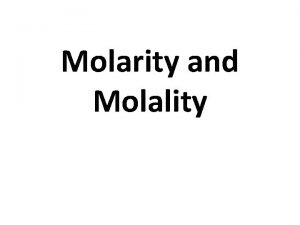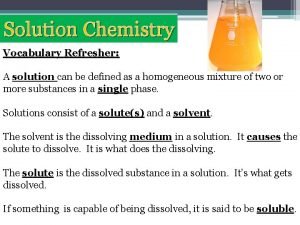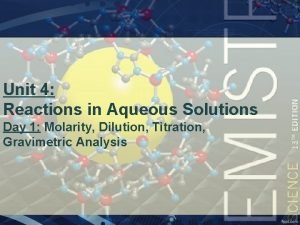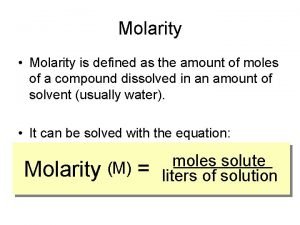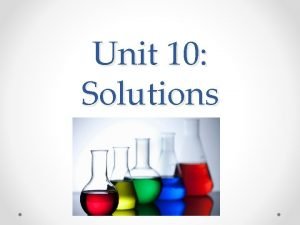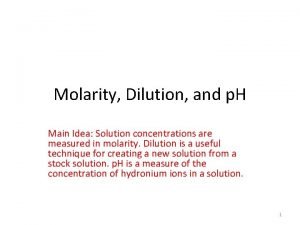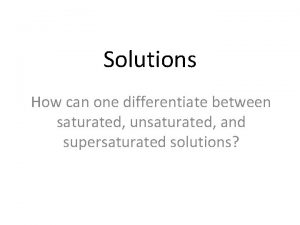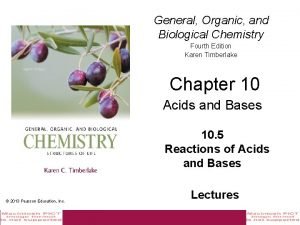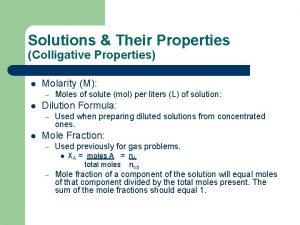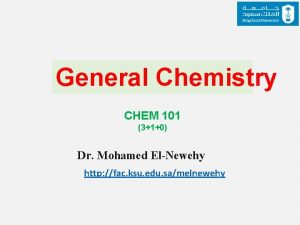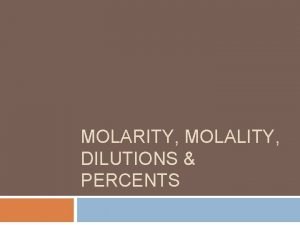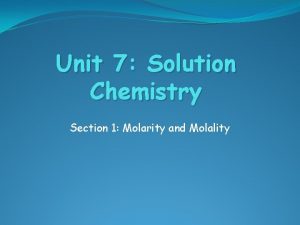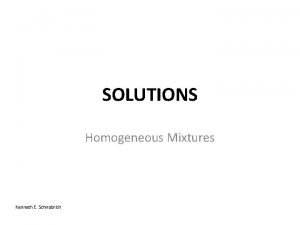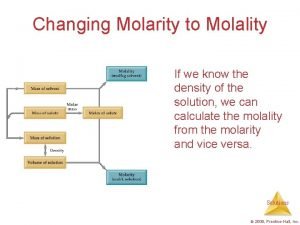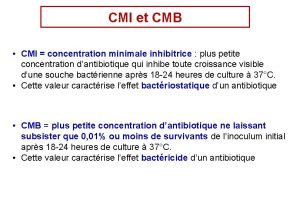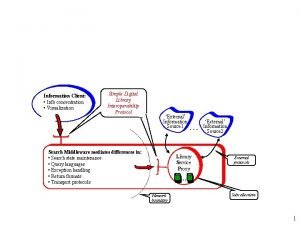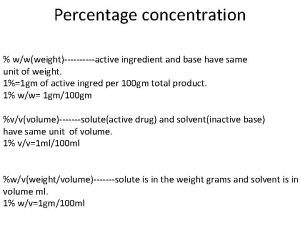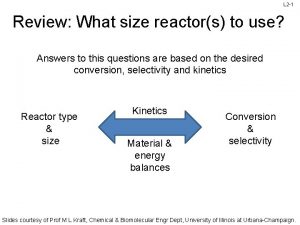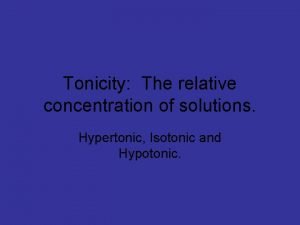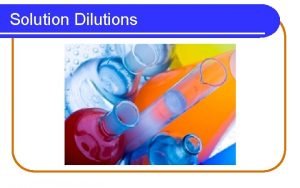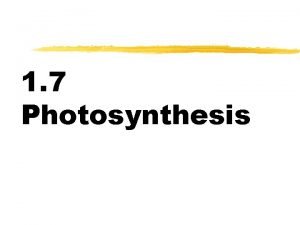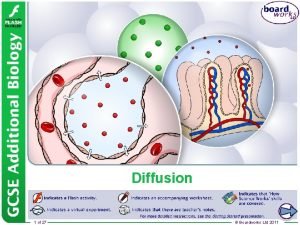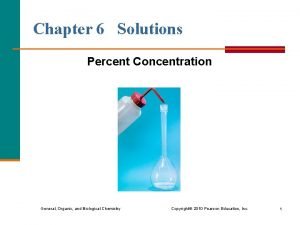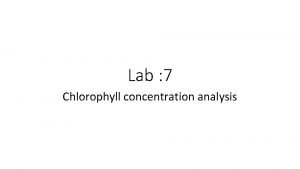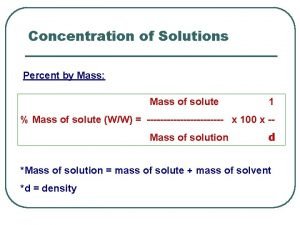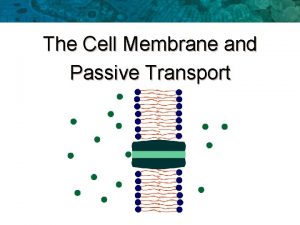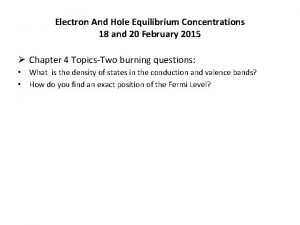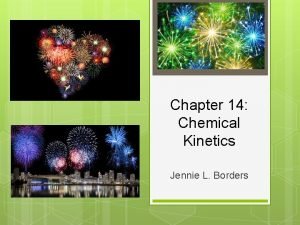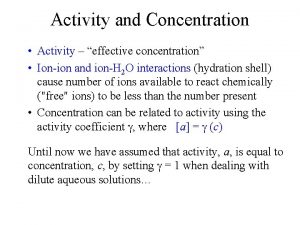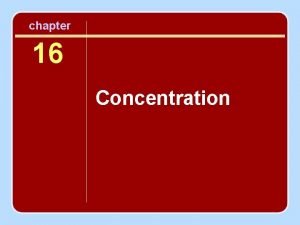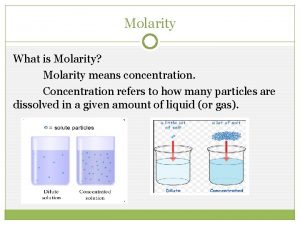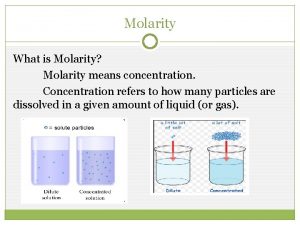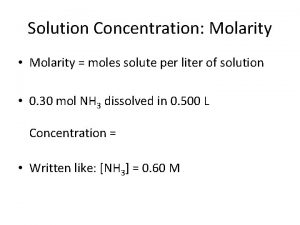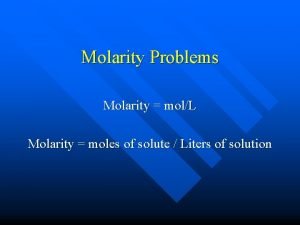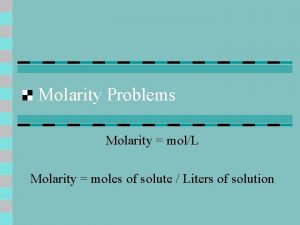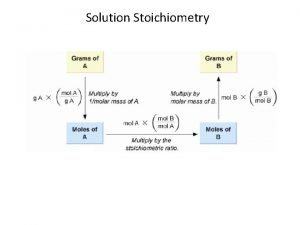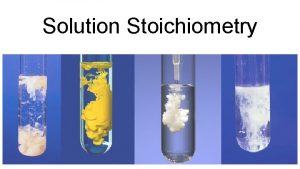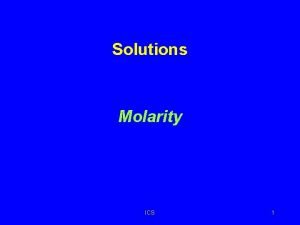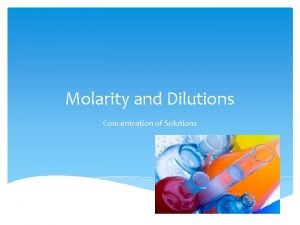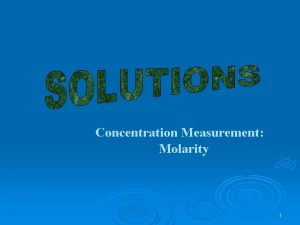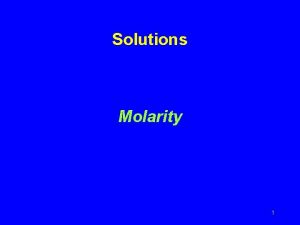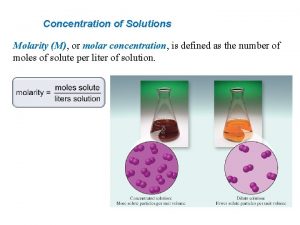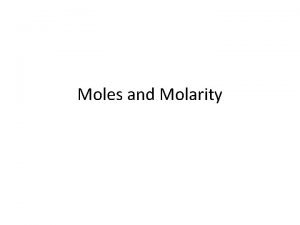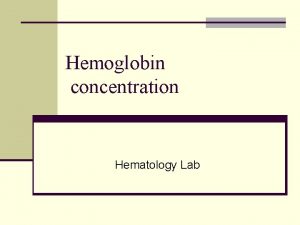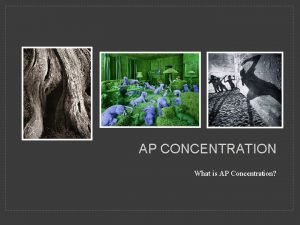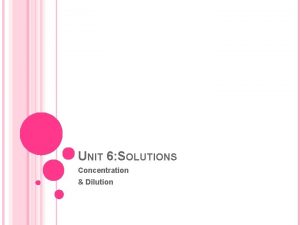Solution Stoichiometry Solution Stoichiometry Solution Concentration Molarity What














































![Finding [H 3 O+] from p. H [H 3 O+] = 10 -p. H Finding [H 3 O+] from p. H [H 3 O+] = 10 -p. H](https://slidetodoc.com/presentation_image_h2/94e8fc5201c84b2288abfa3b0c08a6ae/image-47.jpg)













































- Slides: 92


Solution Stoichiometry

Solution Stoichiometry


Solution Concentration: Molarity What is the concentration of a solution made by dissolving 23. 5 g Ni. Cl 2 into a volume of 250 m. L?

Preparing Solutions: Direct Addition How many grams of Ni. Cl 2 would you use to prepare 100 m. L of a 0. 300 M solution?

Preparing Solutions: Dilution from a concentrated (stock) solution How many m. L of a 2. 60 M Ni. Cl 2 solution would you use to prepare 100 m. L of a 0. 300 M solution?

Titrations: This week’s lab Part 1. “Standardizing” a solution of base: 23. 8 m. L of an Na. OH solution is used to neutralize 1. 020 g H 2 C 2 O 4 -2 H 2 O. What is the concentration of the Na. OH solution?

Titrations: This week’s lab Part 2. Determining the molar mass of an acid: 35. 2 m. L of the same Na. OH solution is used to neutralize 1. 265 g of an unknown diprotic acid. What is the molar mass of the acid?



Preparing Solutions: Dilution from a concentrated (stock) solution How many m. L of a 2. 60 M Ni. Cl 2 solution would you use to prepare 100 m. L of a 0. 300 M solution?

Titrations: The idea



Titrations: This week’s lab Part 1. “Standardizing” a solution of base: 23. 8 m. L of an Na. OH solution is used to neutralize 1. 020 g H 2 C 2 O 4 -2 H 2 O. What is the concentration of the Na. OH solution?

Titrations: This week’s lab Part 2. Determining the molar mass of an acid: 35. 2 m. L of the same Na. OH solution is used to neutralize 1. 265 g of an unknown diprotic acid. What is the molar mass of the acid?


Labs this week…

Chapter 4: Types of Chemical Reactions Goals: • To be able to predict chemical reactivity. • To know how to synthesize specific compounds.

Types of Reactions • • • Acid-Base: proton-transfer Oxidation-Reduction: electron-transfer Precipitation: formation of insoluble salts Gas Forming Organic: – Substitution – Addition – Elimination

Reactions in Aqueous Solution Unless mentioned, all reactions studied this and next week occur in aqueous solution.

Electrolytes Strong Electrolytes: solute breaks apart to give ions in solution. Na. Cl Na+ + Cl. Weak Electrolytes: solute partially breaks apart to give ions. CH 3 CO 2 H CH 3 CO 2 - + H+ Nonelectrolytes: no ions formed. CH 3 CH 2 OH happens less than 5%

Brønsted-Lowery Acid-Base Definitions • An acid is a substance that donates a proton (H+) to a base • A base is a substance that accepts a proton (H+) from an acid

Brønsted-Lowery Definitions • acid: donates a proton (H+) to a base • base: accepts a proton (H+) from an acid • Acid-base reactions can be reversible: reactants products or products reactants

Brønsted-Lowery Definitions • An acid is a substance that donates a proton (H+) to a base • A base is a substance that accepts a proton (H+) from an acid • Acid-base reactions can be reversible: reactants products or products reactants

Important Acids and Bases Strong Acids: HCl hydrochloric HBr hydrobromic HI hydroiodic HNO 3 nitric H 2 SO 4 sulfuric HCl. O 4 perchloric Weak Acid: CH 3 CO 2 H acetic Any other acids are WEAK Strong Bases: Li. OH lithium hydroxide Na. OH sodium hydroxide KOH potassium hydroxide Ca(OH)2 calcium hydroxide Ba(OH)2 barium hydroxide Weak Base: NH 3 ammonia

Weak Acids and Bases

STRONG acids in water: 100% of acid molecules form ions: HCl(aq) + H 2 O(l) H 3 O+(aq) + Cl-(aq) H 3 O+ is hydronium ion

WEAK acids in water, ~5% or less of acid molecules form ions (acetic, H 3 PO 4, H 2 CO 3)

Polyprotic Acids multiple acidic H atoms H 2 SO 4 H+ + HSO 4 - H+ + SO 42 - Not all H’s are acidic: CH 3 CO 2 H

If H 3 PO 4 reacts as an acid, which of the following can it not make? • • 1. H 4 PO 4+ 2. H 2 PO 43. HPO 424. PO 43 -

If C 2 O 4 reacts in an acid-base reaction, which of the following can it not make? 2 - • 1. H 2 C 2 O 4 • 2. HC 2 O 4 • 3. 2 CO 2

Acid-Base Reactions Strong Acid + Strong Base HCl(aq) + Na. OH(aq) Na. Cl(aq) + H 2 O(l) acid base “salt” water

Acid-Base Reactions Diprotic Acids or Bases H 2 SO 4(aq) + Na. OH(aq) H 2 SO 4(aq) + Ba(OH)2(aq) HCl(aq) + Ba(OH)2(aq)

Acid-Base Reactions Strong Acid + Weak Base HCl(aq) + NH 3(aq) NH 4 Cl(aq)

Acid-Base Reactions Weak Acid + Strong Base HCN(aq) + Na. OH(aq) Na. CN(aq) + H 2 O(l) acid base “salt” water

Does the color change prove a reaction occurred? 1. Yes 2. no

Net Ionic Equations HCl(aq) + Na. OH(aq) Na. Cl(aq) + H 2 O(l) What really happens: H+(aq) + OH-(aq) H 2 O(l) Sodium ion and chloride ion are “spectator ions”

Reactions involving weak bases HCl(aq) + NH 3(aq) NH 4+(aq) + Cl-(aq) Net-Ionic Equation: NH 3(aq) + H+(aq) NH 4+(aq)

CH 3 CO 2 H(aq) + Na. OH(aq) 1. 1. CH 3 CO 2 H 2+(aq) + Na. O(aq) 2. 2. CH 3 CO 2 -(aq) + H 2 O(l) + Na+(aq) 3. 3. CH 4(g) + CO 2(g) + H 2 O(l)

HCN(aq) + NH 3(aq) 1. 1. NH 4+(aq) + CN-(aq) 2. 2. H 2 CN+(aq) + NH 2 -(aq) 3. 3. C 2 N 2(s) + 3 H 2(g)

Solution Concentration: Molarity • Molarity = moles solute per liter of solution • 0. 30 mol NH 3 dissolved in 0. 500 L Concentration = • Written like: [NH 3] = 0. 60 M

p. H Scale • In pure water, a few molecules ionize to form H 3 O+ and OH– H 2 O + H 2 O OH– + H 3 O+ • In acidic and basic solutions, these concentrations are not equal acidic: [H 3 O+] > [OH–] basic: [OH–] > [H 3 O+] neutral: [H 3 O+] = [OH–]

p. H Scale • Measure how much H 3 O+ is in a solution using p. H • p. H < 7. 0 = acidic • p. H > 7. 0 = basic • p. H = 7. 0 = neutral • Measure of H 3 O+ and OH– concentration (moles per liter) in a solution • As acidity increases, p. H decreases

p. H Scale • The p. H scale is logarithmic: 100 10 1 0. 01 102 101 100 10– 1 10– 2 log(102) = 2 log(101) = 1 log(100) = 0 log(10– 1) = – 1 log(10– 2) = – 2 • p. H = –log [H 3 O+] • p. H if [H 3 O+] = 10– 5? 10– 9? Acidic or basic? • p. H if [H 3 O+] = 0. 000057 M?
![Finding H 3 O from p H H 3 O 10 p H Finding [H 3 O+] from p. H [H 3 O+] = 10 -p. H](https://slidetodoc.com/presentation_image_h2/94e8fc5201c84b2288abfa3b0c08a6ae/image-47.jpg)
Finding [H 3 O+] from p. H [H 3 O+] = 10 -p. H What is [H 3 O+] if p. H = 8. 9?

p. H: Quantitative Measure of Acidity • Acidity is related to concentration of H+ (or H 3 O +) • p. H = -log[H 3 O+]

Acid-Base reactions CH 3 CO 2 H(aq) + Na. OH(aq) 1. CH 3 CO 2 H 2+(aq) + Na. O(aq) 2. CH 3 CO 2 (aq) + H 2 O(l) + Na+(aq) 3. CH 4(g) + CO 2(g) + H 2 O(l)

Acid-Base reactions HCN(aq) + NH 3(aq) 1. NH 4 +(aq) + CN (aq) + 2. H 2 CN (aq) + NH 2 (aq) 3. C 2 N 2(s) + 3 H 2(g)

Acid-Base Reactions: Find the hidden bases Thing to know: Anions of weak acids are bases. Example: CH 3 COOH = weak acid CH 3 COO- therefore = weak base HCN = weak acid CN- = weak base H 3 PO 4 = weak acid PO 43 - = weak base

Return to Acid-Base Reactions: Find the hidden bases HCl + Na. CN ? HCl + Al. PO 4 ? HCl + Ca. C 2 O 4 ?


Precipitation Reactions Solubility of Ionic Compounds dissolving

To Determine Solubility: 1. identify the two ions 2. soluble ions with no “exceptions” never form precipitates 3. use listing under soluble/insoluble, but check to see if it’s an exception

Examples Soluble or Insoluble? 1. 2. 3. 4. 5. 6. Na. NO 3 Fe. Cl 3 Fe(OH)3 Ba. SO 4 Ag. NO 3 Ag. Cl

More Examples Soluble or Insoluble? 1. 2. 3. 4. 5. 6. K 3 PO 4 Fe 3(PO 4)2 Pb. Cl 2 Fe. SO 4 (NH 4)2 S Pb. S

To Determine Solubility: 1. identify the two ions 2. soluble ions with no “exceptions” never form precipitates 3. use listing under soluble/insoluble, but check to see if it’s an exception

PRS Example 1 Which of the following is soluble? 1. 2. 3. 4. Al. PO 4 Pb. Br 2 Al(OH)3 Fe. SO 4

PRS Example 2 Which of the following is insoluble? 1. 2. 3. 4. Al(NO 3)3 Pb. C 2 O 4 Na. OH Fe. F 3

To Determine Solubility: 1. identify the two ions 2. soluble ions with no “exceptions” never form precipitates 3. use listing under soluble/insoluble, but check to see if it’s an exception

Precipitation Reactions Net Ionic Equations Pb(NO 3)2 + K 2 Cr. O 4 ?

Precipitation Reactions Net Ionic Equations Pb(NO 3)2 + KI ?

Precipitation Reactions Net Ionic Equations Ba. Cl 2 + KNO 3

Acid-Base reactions involving solubility

Acid-Base reactions involving solubility


Gas Forming Reactions 2 H+ + CO 32 - CO 2(g) + H 2 O(l) 2 H+ + SO 32 - SO 2(g) + H 2 O(l) 2 H+ + M H 2(g) + M 2+(aq) M = metal, like Mg or Fe

Oxidation Reduction Reactions Redox Reactions Electron-Transfer Reactions

Oxidation Numbers: A set of rules for tracking charges for atoms in covalent compounds 1. Each atom in a pure element has an oxidation number of zero. 2. For monatomic ions, the oxidation number is equal to the charge on the ion. 3. Fluorine always has an oxidation number of – 1 in compounds with all other elements. 4. Cl, Br, and I always have oxidation numbers of – 1 in compounds, except when combined with oxygen or fluorine. 5. The oxidation number of H is +1 and of O is – 2 in most compounds. • Exception for H: In compounds with metals, H is – 1. • Exception for O: In peroxides, O 22 - ion gives O an oxidation number of – 1. 6. The algebraic sum of the oxidation numbers for the atoms in a neutral compound must be zero; in a polyatomic ion, the sum must be equal to the ion charge.


C in CO 2 1. 2. 3. 4. 5. 6. 7. 8. 9. 10. 1 2 3 4 5 6 7 8 9 0

N in NO 31. 2. 3. 4. 5. 6. 7. 8. 9. 10. 1 2 3 4 5 6 7 8 9 0

Mn in Mn. O 41. 2. 3. 4. 5. 6. 7. 8. 9. 10. 1 2 3 4 5 6 7 8 9 0

Cr in Cr 2 O 721. 2. 3. 4. 5. 6. 7. 8. 9. 10. 1 2 3 4 5 6 7 8 9 0

Oxidation States, Energy, the Economy, and Global Warming

Oxidation-Reduction Reactions Oxidation = loss of electrons = increase in ox # Reduction = gain of electrons = decrease in ox # 4 Fe + 3 O 2 2 Fe 2 O 3 Oxidizing agent = oxidant = gains electrons Reducing agent = reductant = loses electrons

Recognizing Redox Reactions: Always involves changes in oxidation numbers Metals reacting with Nonmetals: 2 Al + 3 Br 2 Al 2 Br 6 Almost anything with Oxygen: 2 Mg + O 2 2 Mg. O Organic Compounds: CH 4 + 2 O 2 CO 2 + H 2 O Others, more difficult to detect: 5 Fe 2+ + Mn. O 4 - + 8 H+ 5 Fe 3+ + Mn 2+ + 4 H 2 O S + O 2 SO 2

1. 4 Al(s) + 3 O 2(g) 2 Al 2 O 3(s) 2. Cu. O(s) + H 2(g) Cu(s) + H 2 O( )

3. Ca. CO 3(s) Ca. O(s) + CO 2(g) 4. Mn. O 4 -(aq) + 5 Fe 2+(aq) + 8 H+(aq) Mn 2+(aq) + 4 H 2 O( ) + 5 Fe 3+(aq)

5. 2 H 2 O 2(aq) 2 H 2 O( ) + O 2(g) 6. Ca. CO 3(s) + 2 H+(aq) CO 2(g) + H 2 O( ) + Ca 2+(aq)

Balancing Redox Reactions Cu(s) + Ag+(aq) Cu 2+(aq) + 2 Ag(s)

Combination and Decomposition Reactions Thermal decomposition of metal carbonates: MCO 3(s) MO(s) + CO 2(g) Combination of two elements to form a compound Zn + S Zn. S

Displacement Reactions Single Displacement Double Displacement


Chemical Synthesis




Organic Reactions A. Combustion Reactions Reaction with oxygen gas to form CO 2 and H 2 O. C 3 H 8(g) + 5 O 2(g) 3 CO 2(g) + 4 H 2 O(l) B. Substitution Reactions Exchange of one atom or molecular fragment.

C. Addition Reactions Addition of two molecules together. D. Elimination Reactions Ejection of a small molecule from a larger one.

E. Isomerization (Rearrangement) Reactions Change of shape of a molecule without gain or loss of any atoms.
 L
L Measures of concentration molarity quiz
Measures of concentration molarity quiz Mass concentration formula
Mass concentration formula Molarity to concentration
Molarity to concentration Unit of concentration in chemistry
Unit of concentration in chemistry Is concentration and molarity the same
Is concentration and molarity the same Measures of concentration molarity
Measures of concentration molarity Molarity
Molarity What is molarity a measurement of?
What is molarity a measurement of? Solution stoichiometry
Solution stoichiometry Molarity and stoichiometry
Molarity and stoichiometry How to find molarity
How to find molarity Solution
Solution Movement of high concentration to low concentration
Movement of high concentration to low concentration Whats a concentration gradient
Whats a concentration gradient What statement describes kcl(aq)
What statement describes kcl(aq) What is the molarity of a solution
What is the molarity of a solution Molar ratio
Molar ratio Molarity of solution
Molarity of solution Units for concentration
Units for concentration Living by chemistry solutions
Living by chemistry solutions Lesson 80 bearly alive solution concentration
Lesson 80 bearly alive solution concentration Concentration of solution
Concentration of solution Solvent vs solute
Solvent vs solute Quantitative expression of solution concentration
Quantitative expression of solution concentration How to get percent concentration
How to get percent concentration How to calculate concentration of solution
How to calculate concentration of solution How to determine concentration of a solution
How to determine concentration of a solution Ppb formula
Ppb formula Solution stoichiometry
Solution stoichiometry Types of chemical reactions and solution stoichiometry
Types of chemical reactions and solution stoichiometry Solution stoichiometry
Solution stoichiometry Types of chemical reactions and solution stoichiometry
Types of chemical reactions and solution stoichiometry How to find moles from molarity
How to find moles from molarity Aqueous reactions and solution stoichiometry
Aqueous reactions and solution stoichiometry Colloids and suspensions
Colloids and suspensions How to calculate molality
How to calculate molality Molarity practice problems
Molarity practice problems Molarity unit
Molarity unit Vocabulary refresher group a answers
Vocabulary refresher group a answers Moles volume molarity triangle
Moles volume molarity triangle Solubility formula class 9
Solubility formula class 9 Chemquest 53 molarity
Chemquest 53 molarity Normality definition
Normality definition How to convert percent to molarity
How to convert percent to molarity Unit 10 solutions
Unit 10 solutions Molar concentration
Molar concentration Example of mole
Example of mole Ppb to molarity
Ppb to molarity Differentiate saturated from unsaturated solution
Differentiate saturated from unsaturated solution Molarity
Molarity Elemental analysis of an unknown pure substance
Elemental analysis of an unknown pure substance Molarity is the number of moles of solute dissolved in
Molarity is the number of moles of solute dissolved in G to molarity
G to molarity Molarity molality
Molarity molality Moles to grams
Moles to grams Chemistry unit 7 molarity
Chemistry unit 7 molarity Definition of molarity
Definition of molarity How to find molality
How to find molality How to calculate percent concentration
How to calculate percent concentration Cmb et cmi
Cmb et cmi Client concentration
Client concentration Bibosomas
Bibosomas How many rakats in each prayer
How many rakats in each prayer Percentage concentration
Percentage concentration Ova cysts and parasites
Ova cysts and parasites Concentration
Concentration Balancing redox reactions in acidic solution
Balancing redox reactions in acidic solution Astenent
Astenent Plasma drug concentration
Plasma drug concentration Vertical
Vertical Relative concentration of isotonic
Relative concentration of isotonic Definition of forensic toxicology
Definition of forensic toxicology Dilution formula
Dilution formula Ap drawing portfolio examples
Ap drawing portfolio examples Carbon dioxide concentration in photosynthesis
Carbon dioxide concentration in photosynthesis Dachau visite virtuelle
Dachau visite virtuelle Concentration gradient
Concentration gradient How to find percent concentration
How to find percent concentration The movement of particles from high to low concentration
The movement of particles from high to low concentration Blood alcohol concentration (bac)
Blood alcohol concentration (bac) Concentration
Concentration How to find percent concentration
How to find percent concentration Mac maximum allowable concentration
Mac maximum allowable concentration Concentration cells
Concentration cells Sucrose solubility curve
Sucrose solubility curve Sedimentation technique for stool concentration
Sedimentation technique for stool concentration Carrier concentration in intrinsic semiconductor
Carrier concentration in intrinsic semiconductor Concentration in chemical reaction
Concentration in chemical reaction Difference between activity and concentration
Difference between activity and concentration Mba investment management concentration
Mba investment management concentration Difference between focus and concentration
Difference between focus and concentration The four-firm concentration ratio
The four-firm concentration ratio
